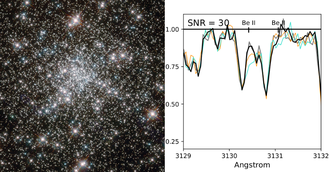
The Cassegrain U-Band Efficient Spectrograph (CUBES) is a new instrument being built for the 8-meter Very Large Telescope (VLT) of the European Southern Observatory (ESO). The Nicolaus Copernicus Astronomical Center (CAMK PAN) is part of the international consortium that is building CUBES. The instrument will provide high sensitivity for spectroscopy in the ground ultraviolet (UV, 300-400 nm), with high (R ~ 23 000) and low (R ~ 7000) resolution.
A team at the Copernicus Astronomical Center, composed of Rodolfo Smiljanic (co-PI of CUBES), Riano Giribaldi (post-doc), and André Rodrigo da Silva (PhD student), simulated observations with CUBES to investigate if the spectra will allow the measurement of beryllium abundances in old metal-poor stars. Beryllium is a light element that is only produced by cosmic-ray spallation in the interstellar medium. The study of beryllium in metal-poor stars can help astronomers to better understand both the formation of globular stellar clusters and the history of star formation of the Milky Way.
However, most old metal-poor stars are faint. Obtaining the UV spectra for large numbers of these stars is beyond the capabilities of existing instrumentation. The new simulations show that the high efficiency of CUBES will enable important progress in the studies of beryllium. With CUBES, it will be possible to obtain UV spectra for stars that are fainter by two magnitudes than currently possible with other instruments from the ground.
The simulations performed at the Copernicus Astronomical Center are described in two papers: “Beryllium abundances in turn-off stars of globular clusters with the CUBES spectrograph” and “Detecting weak beryllium lines with CUBES”. The conceptual design of CUBES is described in the paper "CUBES Phase A design overview". All three papers were recently accepted for publication in Experimental Astronomy.
The research leading to these results has received funding from the Polish National Science Center (OPUS grant nr. 2018/31/B/ST9/01469).
Caption: On the left, an image of the globular cluster NGC 6752 (original image by ESA/Hubble & NASA, under CC BY 4.0, edited by R. Smiljanic). On the right, simulated spectra in the region of the Be spectral lines for dwarf stars belonging to NGC 6752 (from Giribaldi & Smiljanic 2022, published in Experimental Astronomy by Springer Nature).






